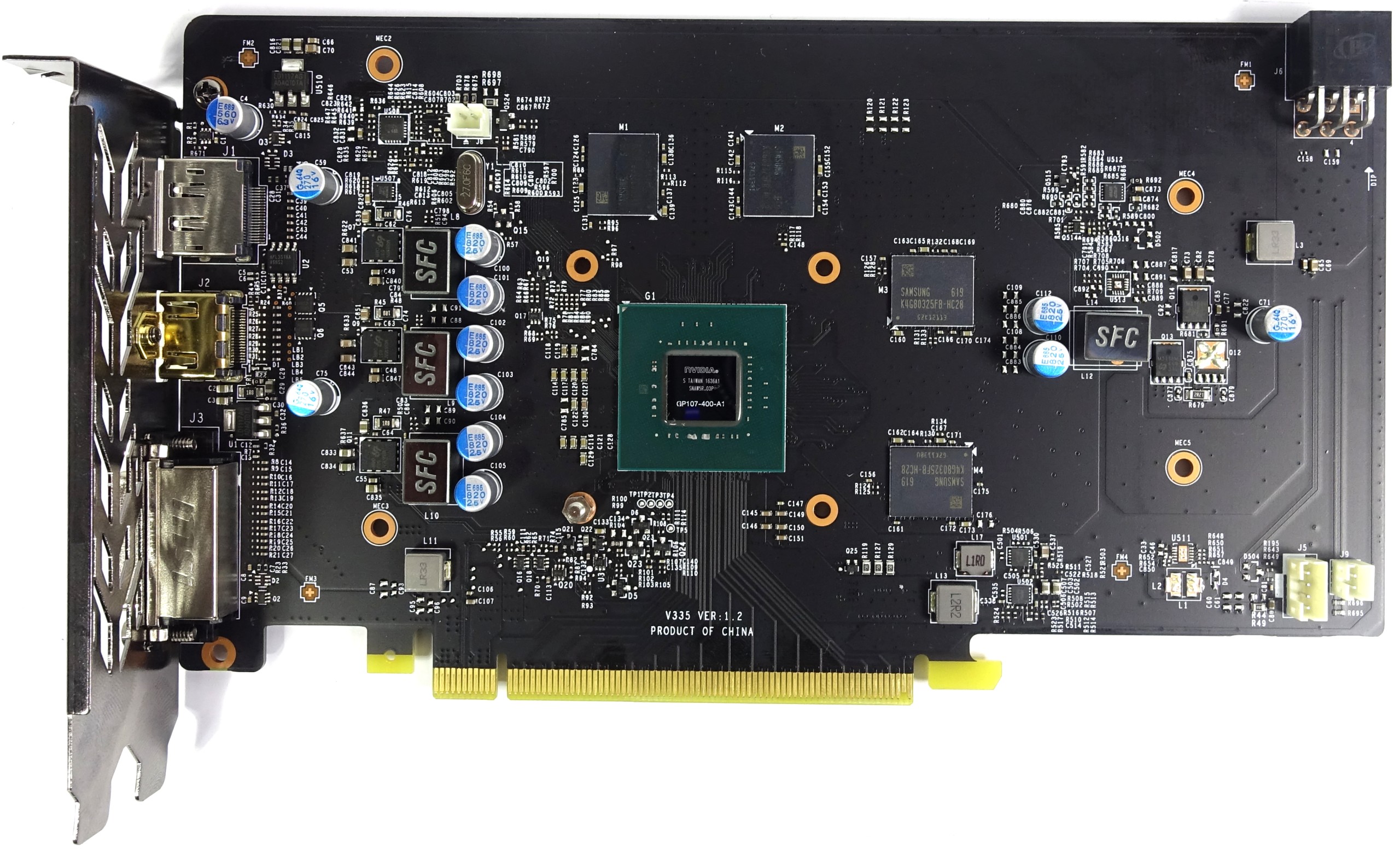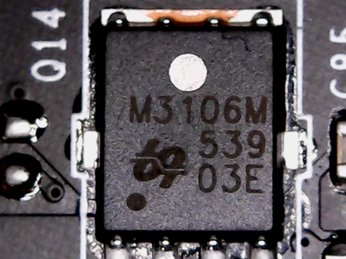Nvidia GeForce GTX 1050 & 1050 Ti Review
A Closer Look At MSI's GeForce GTX 1050 Ti Gaming X 4 GB

Because there is no reference design, our review necessarily covers a partner card. In this case, we have MSI's GeForce GTX 1050 Ti Gaming X 4 GB to take apart and test for power/acoustics. In addition, we have the GeForce GTX 1050 Ti 4G OC and GeForce GTX 1050 2G OC boards in our performance charts.
It might actually be good that there's no Founders Edition this time around (especially after the pricing experiments Nvidia tried with its higher-end models). But there's a clear drawback, too: we only have one specific implementation of the GeForce GTX 1050 and 1050 Ti at our disposal, and other versions will behave differently.
Moreover, the GeForce GTX 1050 Ti Gaming X 4 GB is MSI's flagship in the 1050 Ti series. We have a couple of the simpler and less expensive cards as well, and there will others too. In light of this, the Gaming X card represents the opposite of a baseline in that it’s the most powerful manifestation of GP107.
External Design & Connectors
The card’s cover is made from relatively thin plastic, just like MSI’s other Gaming X family members. It sits on the board's cooler, which is in turn fastened to the PCB. The GeForce GTX 1050 Ti Gaming X 4 GB weighs in at a hefty 526 g, which is mostly due to the large cooling solution.
The length of the card is fairly normal in the performance segment. It measures 22.9 x 12.5 x 3.5 cm (L x H x D required for installation). Of course, that means it occupies two expansion slots. The blades on both fans measure 8.7 cm long, putting them into the 9 cm category.


There is no back plate on the GeForce GTX 1050 Ti Gaming X 4 GB. Not only does this help lower cost, but it's also because a backplate would be pointless for cooling or stabilization.
A peek underneath reveals a single nickel-plated 8 mm composite heat pipe bent in the shape of an S. Its purpose is to spread the GPU’s waste heat to both sides of the cooler’s body.
Stay On the Cutting Edge: Get the Tom's Hardware Newsletter
Get Tom's Hardware's best news and in-depth reviews, straight to your inbox.

A back-lit MSI logo sits up top, and the other side of the heat pipe is visible as well. The six-pin power connector is turned 180° and found at the end of the card. You can bet we'll determine if it's even needed here shortly.

The card's back is completely open and the cooler's fins are positioned horizontally, so some airflow is directed toward the I/O slot cover. This means a significant amount of waste heat is blown out the back, which is a clear advantage compared to models that recirculate warm air.

The slot cover hosts three display outputs that you can use simultaneously in a multi-monitor configuration. There’s a dual-link DVI-D connector (without an analog signal), an HDMI 2.0 port, and a full-sized DisplayPort 1.4 connector.

The parts of the slot cover not occupied by display outputs have air vents. This design works well since all of the connectors are positioned in a line right next to each other.
MSI doesn't bother actively cooling its memory modules. The two modules above the GPU contact the heat sink through two small thermal pads, while the other two (and the voltage regulators) are cooled by air passing over them.
Cooler Design
The cooler’s body is a lot simpler than the one we saw on MSI's 6 GB GeForce GTX 1060. Then again, it doesn’t have to handle as much waste heat. MSI’s larger Gaming X graphics cards have nickel-plated sinks. The GeForce GTX 1050 Ti Gaming X 4 GB employs a simple aluminum design instead.

The 8 mm heat pipe is flattened on one side and pressed into the sink on the other. This design is advantageous when it's used with small GPUs that don't get particularly hot like Nvidia's GP107.
Board & Power Supply
MSI's PCB isn't particularly crowded, which makes it easier to keep neat. The company could have made this board much smaller (and indeed our MSI GeForce GTX 1050 Ti 4G OC and GeForce GTX 1050 2G OC boards are quite compact).

The GPU power supply’s three phases are controlled by a uP9509 manufactured by uPI Semiconductor Corp. Voltage regulators for both the high and low side consist of highly integrated Dual N-Channel MOSFETs. The M3816 that MSI uses doesn’t need separate gate drivers, and it includes the Schottky diode. What results is a simpler layout.


The memory modules are fed by a single power phase controlled by uPI Semiconductor's smaller uP1537. MSI uses two different voltage regulators here: an M3116 for the high side and a stronger M3106 on the low side. The gate driver and Schottky diode are separate components this time.


The days of using an INA1221 for current monitoring are long gone. A simple and discrete solution is in its place. MSI's favorite coils do make another appearance, though. They are of average mass-market quality with sufficient encapsulation. They are certainly better than Foxconn’s magic coils, but have the drawback that they need to be assembled manually.


The card we're taking apart is a 4 GB GeForce GTX 1050 Ti, though of course we have two other boards for performance testing. The memory modules on this particular model, however, come from Samsung, have a capacity of 8 Gb (32x 256 Mb) each, and bear the model number K4G80325FB-HC28. Operating voltages depend on clock rate, and range from 1.305 to 1.597V. There should be some room for a manual overclock, though we don't want to exceed 85 °C.
MORE: Best Graphics Cards
MORE: Desktop GPU Performance Hierarchy Table
MORE: All Graphics Content
Current page: A Closer Look At MSI's GeForce GTX 1050 Ti Gaming X 4 GB
Prev Page Meet GeForce GTX 1050 & 1050 Ti Next Page How We Tested GeForce GTX 1050 & 1050 Ti-
WildCard999 EVGA GTX 1050 ti around $150Reply
http://www.evga.com/Products/ProductList.aspx?type=0&family=GeForce+10+Series+Family&chipset=GTX+1050+Ti
EVGA GTX 1050 around $120
http://www.evga.com/Products/ProductList.aspx?type=0&family=GeForce+10+Series+Family&chipset=GTX+1050
It will probably be about $20-$30 more for the SSC & FTW versions. -
elbert Leaks suggested the 1050ti is as fast as the 960 and R9 280. I would love to have seen if that was true. My 280 is getting old and needs an upgrade. Any chance those can be added to the benchmarks?Reply -
tslot05qsljgo9ed Blind TrollReply
Zortac GTX 1050 Mini: $109.95
Zortac GTX 1050 Ti Mini: $139.95
http://www.newegg.com/Product/ProductList.aspx?Submit=ENE&IsNodeId=1&Description=1050&bop=And&SrchInDesc=zotac&Page=1&PageSize=36&order=BESTMATCH -
Corwin65 Reply18776894 said:Blind Troll
Zortac GTX 1050 Mini: $109.95
Zortac GTX 1050 Ti Mini: $139.95
http://www.newegg.com/Product/ProductList.aspx?Submit=ENE&IsNodeId=1&Description=1050&bop=And&SrchInDesc=zotac&Page=1&PageSize=36&order=BESTMATCH
If you're in the market snag one of those before prices jump. -
cdrkf @Elbert no way the 1050ti is going to best the 280, it's just not got enough resources behind it.Reply
You'd be far better looking at an RX 470 / 480 card or one of the 1060 cards imo. The only advantage to the 1050ti over your current card is lower power consumption, although the 280 isn't that bad anyhow. -
artk2219 All I am seeing is a nice pricewar brewing for the midrange segment. The RX 460 needs to drop to 90 to 95. and the 470 should ideally drop to 150 to 160. On Nvidias end the 1050 is just fine at 110, but the ti needs to drop to 130 to 135. Either way, i would save a little more and take a used R9 290 over any of them, but thats me. The only real reason to be crazy excited about the 1050, is if your limited to a single slot case and need a low power but decent performance card. In which case the 1050's are an excellent option, we really could use a nice single slot card.Reply -
spdragoo @Elbert: Didn't find direct comparisons to the R9 280, but Techspot's review showed benchmark comparisons to the R9 380 (which is pretty much on par with the 280):Reply
http://www.techspot.com/review/1269-nvidia-geforce-gtx-1050/
@CDRKF: Technically, you're correct: the GTX 1050Ti didn't (consistently) put in a better performance than the GTX 960 or R9 380. However, there were a couple of games that it beat them in (beating the 960 more often than the 380), & even when it didn't beat them its performance was right in the ballpark. To me, that says that either the 1050 or 1050Ti would make an excellent card for someone wanting to replace a broken R9 280/280 or GTX 960, but doesn't have the budget for a GTX 1060 or RX 470/480, & especially a good choice for someone whose system (*cough* OEM garbage *cough*) doesn't allow them to use a GPU that requires PCIe power connectors...as long as they're not expecting to game any higher than 1080p resolutions.
